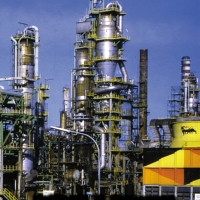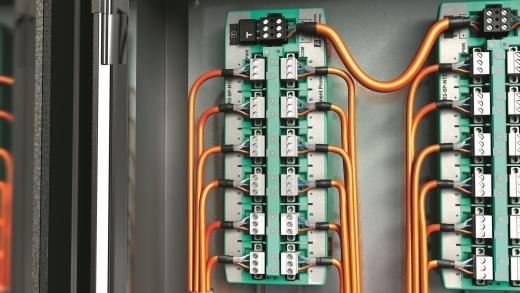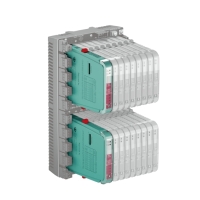Fieldbus Components for First EST Plant of Eni at Sannazzaro dè Burgondi, Italy [Reference]
Project details

Around 15,000 I/O signals have been permanently wired at Sannazzaro dè Burgondi
Customer | Eni
Project | Implementing fieldbus components into the first EST plant architecture
Location | Sannazzaro dè Burgondi, Italy
Completion | October 2013
Project report
The customer
During the course of a major project, establishing a new procedure can present challenges. Combining innovation with the necessary safety and reliability is an essential requirement in the field of oil and gas processing.
In May 2011, Eni, one of the largest integrated companies in the energy sector together with the plant engineering specialists of Saipem, Italy’s biggest company, laid the foundation for the first EST plant at Sannazzaro dè Burgondi. EST stands for “Eni Slurry Technology.” EST is a new procedure that was developed to convert waste materials from the refinery process to valuable products.
With EST, the refinery now uses and upgrades crude oil with characteristics such as very heavy crude oil, bitumen, and sump oil. The plant is also used for research and development by Eni. Only a process architecture that measures up to state-of-the-art standards is capable of handling this demanding application profile.
The requirements
Eni and Saipem defined direct information exchange within the architecture as the focal point of a sustainable solution. Despite the fact that the installation would be spread over several areas of the plant, a comprehensive overall integration still had to be assured.
The following components were required to work together effectively as one system:
- Distributed Control System
- Emergency Shut Down
- Fire Protection Devices
On the basis of this requirement, fieldbus technology appeared as the ideal solution to connect status, alarm, and diagnostic functions across the plant. Still, Eni and Saipem had to find partners who could establish the comprehensive integration of all process data into one system.
The solution
Yokogawa and Pepperl+Fuchs offered the suitable solution for the demanding application. Distributed Control System, Emergency Shut Down, and Fire Protection Devices are fully integrated in the system architecture that was installed by Yokogawa. Around 15,000 I/O signals have been permanently wired. 5,500 fieldbus instruments are operated by means of 650 segments.
Alessandro Malberti, product manager at Yokogawa Italy, explained: "The solution encompasses all systems: DCS, ESD, and F&G. These facilitate the direct exchange of information within the architecture, whereby just one redundant bus is used to link all systems together. The topography proposed by Yokogawa is based on the integration of the Centum VP distributed control system (DCS) with the ProSafe RS ESD system and includes all control and safety functions." Plant Asset Management is implemented with the PRM module.
The infrastructure components by Pepperl+Fuchs ensure that the FOUNDATION fieldbus H1 segments are working properly. Prewired segment protector junction boxes for Zone 2 provide intrinsically safe connections for instruments to the High-Power Trunk. This concept allows long cable distances and high device counts per segment at the same time. They connect the field devices with features protecting process automation and ensuring availability such as short-circuit protection. Due to FOUNDATION Fieldbus technology, third-party products can be applied easily. For instance, instrumentation by Metso, Emerson, Vega, Biffi, and Auma is integrated at the refinery.

Equipped with accessories and prewired in the stainless steel enclosure: "Segment Protector" junction boxes for Zone 2 and explosion protection for intrinsic safety "Ex ic"

Due to the Advanced Diagnostics Module (ADM), maintenance work is no longer done preventively, but only when an actual demand had been diagnosed
The Advanced Diagnostics Module (ADM), developed and manufactured by Pepperl+Fuchs, enables fast commissioning of fieldbus segments. During operation the physical layer diagnostics of the ADM allow rapid fault detection. The expert system interprets notifications and signals from the fieldbus installation, translates them into understandable words, and even suggests a solution to the maintenance staff. With those features, the ADM supports the timely maintenance and full availability of the fieldbus segments for Eni. Maintenance work is no longer done preventively, but only when an actual demand had been diagnosed.
"We believe it is our responsibility to guarantee the orderly functioning of the FOUNDATION fieldbus segments over a long period, which is why we chose the solution offered by Pepperl+Fuchs," stated Yokogawa's product manager. "The Advanced Diagnostics Module produced by Pepperl+Fuchs enables us to implement continuous monitoring, even for the installation technology integrated in the asset management system."
At Sannazzaro dè Burgondi, integrated systems and powerful fieldbus technology now secure high availability, comprehensive data flow, and low maintenance costs.





 +48 22 256 9770
+48 22 256 9770